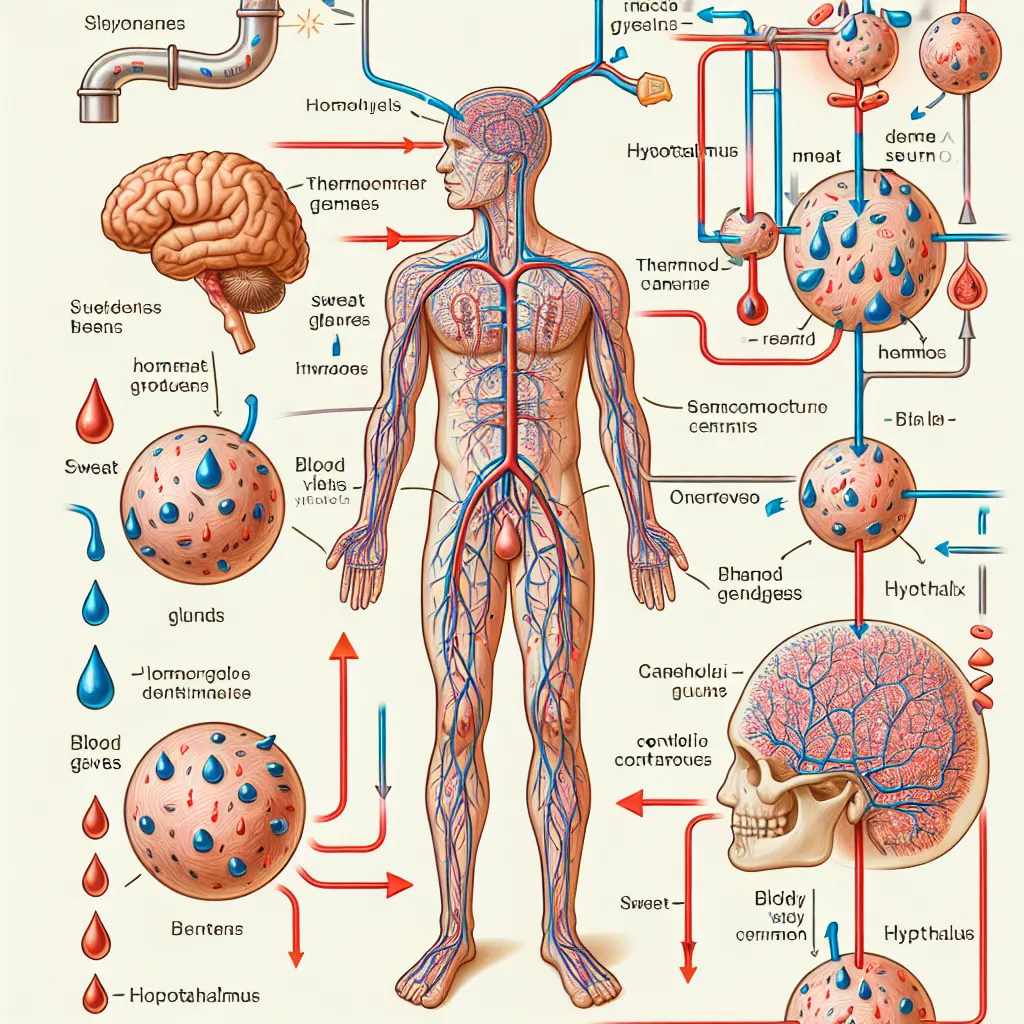Thermoregulation is a crucial biological concept that often appears in IELTS exams, especially in the Reading and Writing sections. Let’s explore this term in depth to enhance your vocabulary and boost your IELTS score.
Nội dung bài viết
- Definition and Pronunciation
- Context and Usage
- Examples in Context
- Common Contexts
- Frequency in IELTS
- Vocabulary Analysis
- Word Structure
- Synonyms and Related Terms
- Antonyms and Contrasting Concepts
- Memorization Techniques
- Mind Mapping
- Mnemonic Device
- Practice Exercises
- Application in IELTS Writing
- IELTS-style Reading Question
- Conclusion
Definition and Pronunciation
Thermoregulation (noun)
Pronunciation: /ˌθɜːməʊˌreɡjʊˈleɪʃən/
Definition: The process by which an organism maintains its body temperature within certain boundaries, even when the surrounding temperature is different.

Context and Usage
Examples in Context
-
Thermoregulation in mammals involves complex physiological mechanisms to maintain a constant body temperature.
Analysis: This sentence introduces the concept in a scientific context, emphasizing its importance in mammalian biology. -
The human body’s thermoregulation system works efficiently to keep our core temperature around 37°C (98.6°F).
Analysis: Here, the term is used to describe a specific aspect of human physiology, providing a concrete example of its function. -
Reptiles rely on external sources of heat for thermoregulation, a process known as ectothermy.
Analysis: This example contrasts mammalian thermoregulation with that of reptiles, introducing related terminology. -
Climate change poses significant challenges to the thermoregulation capabilities of many species.
Analysis: The term is used in an environmental context, linking it to current global issues. -
Researchers are developing new fabrics that mimic biological thermoregulation for more efficient clothing.
Analysis: This sentence demonstrates the application of the concept in technology and innovation.
Common Contexts
Thermoregulation is frequently discussed in:
- Biology and physiology textbooks and research papers
- Environmental science discussions, particularly regarding climate change impacts
- Sports science, when discussing athletic performance in various conditions
- Zoology and comparative biology studies
- Medical contexts, especially related to fever and hypothermia
Frequency in IELTS
Thermoregulation appears moderately often in IELTS exams, particularly in:
- Reading passages on biology, environmental science, or animal behavior
- Writing Task 2 essays discussing climate change or human adaptation
- Speaking Part 3 questions related to environmental issues or human physiology
While not among the most common terms, understanding thermoregulation can give you an edge in comprehending complex scientific texts and articulating ideas about biology and the environment.
Vocabulary Analysis
Word Structure
- Thermo- (prefix): Relating to heat or temperature
- Regulation (root): The act of controlling or maintaining order
Understanding this structure helps in recognizing related terms like thermometer, thermostat, or thermonuclear.
Synonyms and Related Terms
- Temperature regulation
- Heat balance
- Homeostasis (broader term that includes thermoregulation)
- Temperature homeostasis
Antonyms and Contrasting Concepts
- Thermal instability
- Temperature fluctuation
- Poikilothermy (inability to regulate body temperature)
Memorization Techniques
Mind Mapping
Create a mind map with ‘Thermoregulation’ at the center, branching out to:
- Mechanisms (sweating, shivering, vasodilation, vasoconstriction)
- Types of organisms (endotherms, ectotherms)
- Environmental factors (ambient temperature, humidity)
- Related physiological processes (metabolism, circulation)
Mnemonic Device
Remember the key aspects of thermoregulation with the acronym HEAT:
- H: Homeostasis maintenance
- E: Energy balance
- A: Adaptation to environment
- T: Temperature control
Practice Exercises
Application in IELTS Writing
Task: Write a paragraph explaining how climate change might affect animal thermoregulation. Use at least three related terms from this lesson.
Sample answer:
Climate change poses significant challenges to animal thermoregulation. As global temperatures rise, many species struggle to maintain their optimal body temperature through traditional methods of heat balance. This is particularly problematic for ectotherms, whose temperature regulation relies heavily on external environmental conditions. Some animals may need to alter their behavior or habitat preferences to achieve homeostasis, while others might face the risk of overheating or energy depletion due to increased metabolic demands.
IELTS-style Reading Question
Read the following passage and answer the question:
Thermoregulation is a critical process for maintaining life in many organisms. In mammals, the hypothalamus acts as a thermostat, initiating responses to both high and low temperatures. When body temperature rises, blood vessels dilate, and sweating increases to release heat. Conversely, when temperature drops, shivering generates heat, and blood vessels constrict to conserve it.
Question: Which part of the mammalian brain is responsible for thermoregulation?
A) Cerebellum
B) Hypothalamus
C) Amygdala
D) Hippocampus
Answer: B) Hypothalamus
Conclusion
Mastering the concept of thermoregulation not only enhances your scientific vocabulary but also provides you with a powerful tool for discussing various topics in the IELTS exam. From biology to environmental science, this term opens doors to articulate complex ideas about how organisms interact with their environment.
Remember to practice using this term in your writing and speaking exercises. Try to link it with current events or environmental issues to demonstrate a broad understanding of its applications. Don’t hesitate to use the comment section below to share your own sentences using ‘thermoregulation’ or to ask any questions about this fascinating biological process!
To further expand your IELTS vocabulary related to environmental topics, you might find our article on heat acclimatization helpful. It explores another crucial aspect of how organisms adapt to temperature changes, which complements your understanding of thermoregulation.